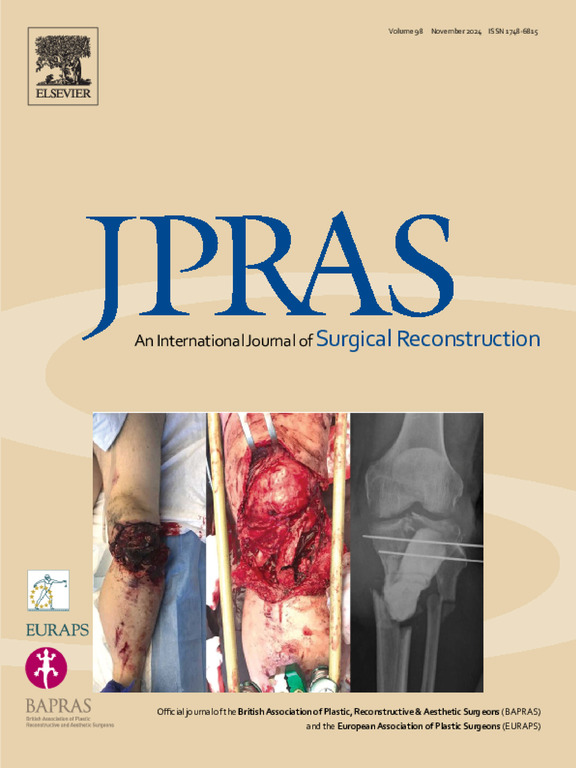既往放疗乳房的缩乳和乳房切除术:一项回顾性研究。
IF 2.4
3区 医学
Q2 SURGERY
Journal of Plastic Reconstructive and Aesthetic Surgery
Pub Date : 2025-09-08
DOI:10.1016/j.bjps.2025.08.042
引用次数: 0
摘要
背景:尽管治疗后不对称和大乳房畸形的发生率很高,但放疗后纤维化和血管损伤明显使先前接受过放疗的患者的择期乳房手术复杂化。本研究评估了手术技术的并发症概况,为放疗乳房的缩乳和乳房切除术提供循证指导。方法:回顾性分析2015-2023年间41例既往乳房放疗患者,分别接受双侧缩乳(n=30)、乳房固定术(n=7)或混合手术(n=4)。复位技术包括上蒂(n=4)、上内侧蒂(n=12)和Thorek游离乳头移植(n=14);乳房切除术采用Wise-pattern优越椎弓根技术。结果比较了1442例未放疗的乳房缩小术。并发症分为严重(需要再手术)和轻微(保守治疗)。统计分析采用Fisher精确检验和比值比(SPSS v26)。结果:与未放疗的对照组相比,放疗乳房的总并发症发生率明显更高(44%对21%;OR 3.017; p=0.0014),血清肿只发生在放疗病例中(15%对0%)。结论:在技术特定风险特征和保守组织处理的指导下,在放疗领域进行乳房手术仍然是可行的。乳房固定术会增加乳房破裂的风险,而Thorek技术可以减少高危患者的血清肿形成。由于亚组分析的效力不足,所有与技术相关的建议都应被视为初步的和产生假设的,有待于在更大的多中心队列中验证。本文章由计算机程序翻译,如有差异,请以英文原文为准。
Breast reduction and mastopexy procedures on previously irradiated breasts: A retrospective study
Background
Post-radiation fibrosis and vascular compromise significantly complicate elective breast surgeries in previously irradiated patients, despite a high incidence of post-treatment asymmetry and macromastia. This study evaluates complication profiles across surgical techniques to provide evidence-based guidance for breast reduction and mastopexy in irradiated breasts.
Methods
A retrospective cohort of 41 patients with prior breast irradiation undergoing bilateral breast reduction (n=30), mastopexy (n=7), or mixed procedures (n=4) between 2015–2023 was analyzed. Reduction techniques included superior pedicle (n=4), supero-medial pedicle (n=12), and Thorek free nipple graft (n=14); mastopexies employed Wise-pattern superior pedicle techniques. Outcomes were compared with 1442 non-irradiated breast reductions. Complications were classified as major (reoperation required) or minor (conservatively managed). Statistical analysis utilized Fisher’s exact tests and odds ratios (SPSS v26).
Results
Irradiated breasts had significantly higher overall complication rates compared to non-irradiated controls (44% vs. 21%; OR 3.017; p=0.0014), with seromas occurring exclusively in irradiated cases (15% vs. 0%; p<0.001). Mastopexies showed higher dehiscence rates than reductions (29% vs. 0%; p=0.01). Among reduction techniques, the supero-medial pedicle had the highest complication rate (67%), while Thorek procedures showed no seromas (p=0.04). No major complications occurred; revisions (15%) addressed asymmetry only.
Conclusions
Breast surgery in irradiated fields remains viable when guided by technique-specific risk profiles and conservative tissue handling. Mastopexy carries elevated dehiscence risks, while the Thorek technique may reduce seroma formation in high-risk patients. Because subgroup analyses were under-powered, all technique-related recommendations should be regarded as preliminary and hypothesis-generating, pending validation in larger multicentre cohorts.
求助全文
通过发布文献求助,成功后即可免费获取论文全文。
去求助
来源期刊
CiteScore
3.10
自引率
11.10%
发文量
578
审稿时长
3.5 months
期刊介绍:
JPRAS An International Journal of Surgical Reconstruction is one of the world''s leading international journals, covering all the reconstructive and aesthetic aspects of plastic surgery.
The journal presents the latest surgical procedures with audit and outcome studies of new and established techniques in plastic surgery including: cleft lip and palate and other heads and neck surgery, hand surgery, lower limb trauma, burns, skin cancer, breast surgery and aesthetic surgery.

 求助内容:
求助内容: 应助结果提醒方式:
应助结果提醒方式:


